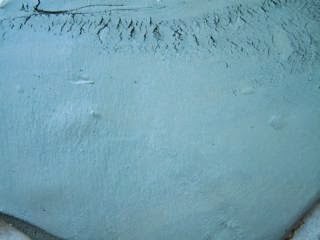Submitted by: Maia Stark, Gallery Assistant
I was lucky enough, this summer, to participate in a university class offered by the U of S which taught soil science and art students alike to grind their own pigments and make paint from natural and local sources. It was an incredible experience for many of us, who had only ever bought paints from a store and had no clue what chemicals and minerals made “ochre yellow” different from “burnt sienna”. We made black pigment out of burnt bone, yellows and reds from soil samples, and greens and blues from types of rocks (such as malachite and azurite). It was a fascinating course, and I couldn’t help but wonder about the potential for craftspersons to find their own local clay for pottery and sculpture—as some of the soils we used to make pigment were certainly fine enough to be used for pottery and ceramic work. While I myself am not a ceramic artist or sculptor, one of the other MFA students collected clay while we were up north, and has herself previously sourced local clay for her work. For this post, then, while it is still fresh in my mind, I’d like to share some of the research I’ve done on using natural sources for artist materials, in particular, clay!
First off, a quick note that digging for clay and soils should be done in such a way that the environment is minimally disturbed. The University of Minnesota Natural Resources Research Institute website has some helpful tips for digging your own “pedon,” or soil pit.
“. . .it is best to use a shovel with a flat, square spade so the sides of the pit can be smooth and relatively undisturbed. Dig a pit at least 1/3 of a meter (~ 1 foot) on each side and at least 35 centimeters (~1 foot) or more deep. Don’t be too destructive; only dig a pit large enough so that you can see the layers of soil relatively easily. Take care so that at least one side of the pit is straight down and smooth, so that the natural layering of the soil visible and not disturbed by the digging. When you are finished, be sure to put the soil back into the pit, or mark it so people will see it and not fall into it!”
–NRRI
 |
| Clay from Exeter, New Hampshire (Kit Cornell Pottery) |
 |
| An excavation in Exeter reveals a cache of local clay (Kit Cornell Pottery) |
When you are digging for your clay, you will probably end up with a collection of clay and less fine types of soil mixed in. However, this doesn’t mean you have to painstakingly pick out all the good clay when you first take your sample of soil.
Eddie Starnater of the website “Practical Primitive” has a method of extracting good quality clay from samples which are full of less fine soil and sand by using water to separate the materials. Clay is lighter than sand and so by settling the mixtures (letting heavier soils fall to the bottom), one can quite easily obtain a good quantity of pure clay. This process, though not physically laborious, does have to take place over several days (Starnater’s process can be found here).
There are other ways of separating your clay from extraneous matter, and Kit Cornell of Kit Cornell Pottery has a method which is outline on her website, here.
Cornell is an artist from New Hampshire who uses clay that she finds locally. On her website, Cornell notes that naturally sourced clay, as opposed to commercially bought clay, can have wonderful surprises in colouring, as the influence of mineral and chemical deposits will vary the clay’s raw colour from reds and browns to even greens.
For Cornell, using local sources of clay for pottery and local oxides and ash for glazing is an important part of producing handmade products. This has been a very attractive concept to me, as well, after taking the course which taught me to harvest my own pigments. Being able to supply my own materials enhances the concept of the local and handmade (while also being accommodating financially)! For instructions and information about Cornell’s process, check out her page on clay here.
